Affiliate disclosure: This post may contain affiliate links. Please see our Privacy Policy.
Every fall the hedgerows are filled with color in my neighborhood. Thimbleberries and wild plums dot the roadside, and the clusters of bright red highbush cranberry are visible from a distance.
I’ve seen those bushes every fall for the past 6 years and never gotten around to harvesting. In early September there are so many wild edibles, and they never made it to the top of my list.
This year, I learned that the bark of highbush cranberry is a potent medicinal, and that got me out foraging the very next day.
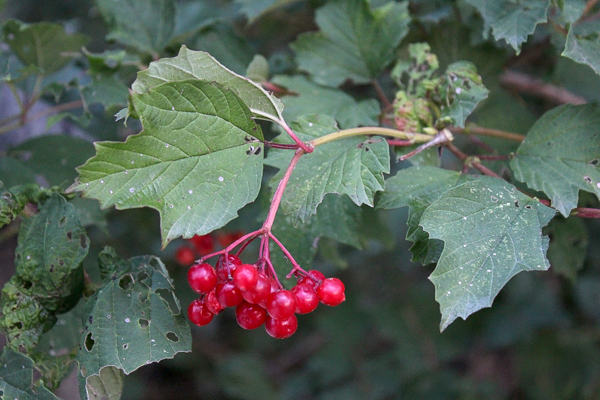
As a child, I always imagined cranberries grew on bushes, in much the same way as blueberries. True cranberries (Vaccinium sp.) are actually a spreading groundcover with long thin tendrils. The “cranberries” that grow on bushes aren’t technically cranberries, but a group of species of viburnum that happens to produce somewhat edible fruit.
There are three species of plant called highbush cranberry which makes things a bit more confusing.
- Viburnum opulus – A European native with unpalatable fruit. It’s been introduced to the US in ornamental plantings, and it readily hybridizes with native highbush cranberries. This species is also called Guelder rose.
- Viburnum trilobum – A highbush cranberry species native to the northeastern United States. The fruit are tart, but rich in vitamin C. They taste a lot like cranberries, but they have one large seed instead of many small ones. They were a traditional food of native American peoples, and they’re still made into jams, syrups, and pies.
- Viburnum edule – A highbush cranberry species that is commonly called squashberry. It’s native to Northern portions of the US and all of Canada. This is the best tasting highbush cranberry species.
It’s almost impossible to distinguish between the species, as the only visible differences are in the flowers. The distinctions are so minor that they’ll require a very close eye and a botany degree.
Those flowers will be long gone by the time you find the highbush cranberries. Practically speaking, the best way to tell the difference is to taste the berries.
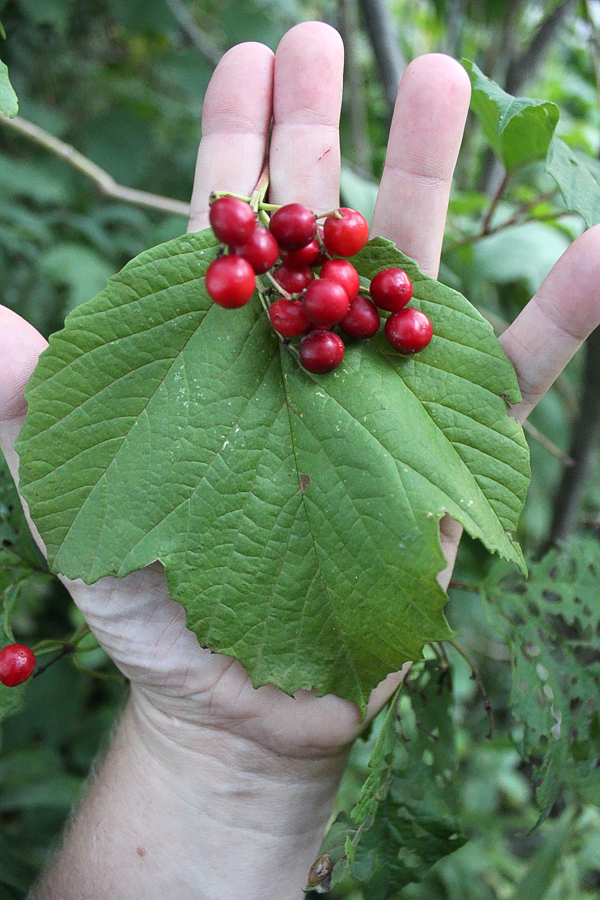
I tentatively bit into my first one and spit immediately. I spit 5 more times, and the first time I swallowed the tiny bit of residue in my mouth made me regret it. Looks like I’ve definitively found a Viburnum opulus!
They’re listed as edible in small quantities, but potentially toxic in large amounts. I can’t imagine voluntarily eating a whole one, so no worries there.
If you did somehow manage to eat them, the side effects are diarrhea and vomiting. I’m pretty sure if a whole one of those went into my mouth, vomiting would have been on the agenda.
This bush was in a spot that had gone a bit wild on the roadside, but given where it was, I could believe that it was part of an ornamental planting at some point in the past. It had the fullest clusters of berries and was by far the showiest plant I came across. Beware that I guess, if the highbush cranberry is too pretty that might be a warning sign…
I also ran across a number of other scrubbier highbush cranberries. One of them was notably different. The berries came in small clusters, groups of 2, 3 or 4.
The individual berries were also larger and rounder than the ones on the showy bush.
I tentatively gave it a bite…and it was tasty. Sour and acidic, but definitely not the same poison taste that I’d had in my mouth earlier.
I know it’s not much of a distinction, but the “good tasting” highbush cranberry is to the left in my hand in this photo next to the horrible ones. Can you tell them apart? Not without tasting them.
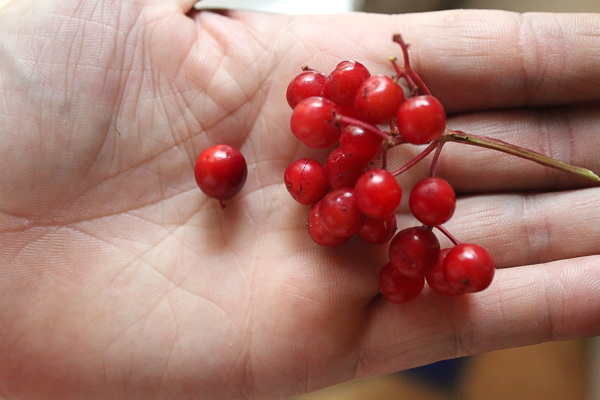
The fruit looked more or less exactly like this positively ID’d cluster photo taken by the US Forest below.
But, honestly meaningful distinctions between species are hard.
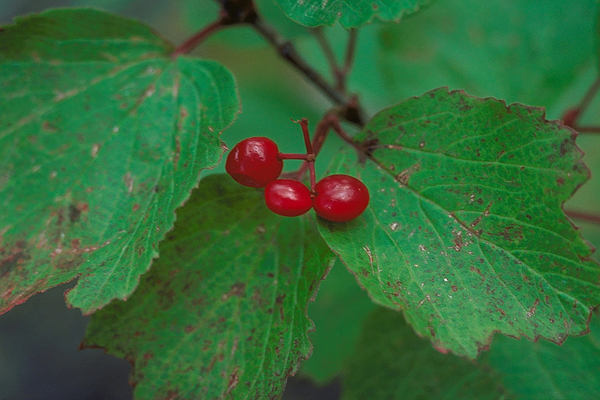
Small clusters of fruit, and the leaves beginning to turn autumn colors against the ripe fruit.
Here’s a picture of the fruit on the tasty highbush cranberry:
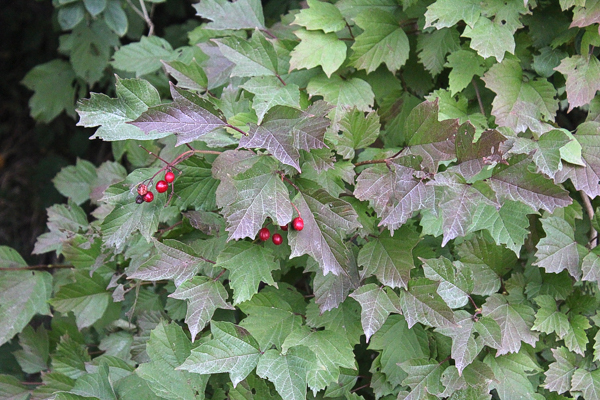
The moral of the story is, be sure to test every single bush before putting it in your foraging basket. If you’re really out in the bush, you’re much safer and less likely to encounter the unpalatable ornamental fruit. If you’re in the Northwest, Viburnum edule is the dominant species so you’re likely to find tasty berries, but still, check to be sure.
One other thing to note if you’re going to cook with highbush cranberry. While the completely unrelated lowbush cranberry has small, unobtrusive seeds, the seeds inside highbush cranberry are huge.
They’re flat and round, and they cut through the whole fruit. The seed is almost as large as the fruit, as it is in a chokecherry or pin cherry, but since the seed is flat so there’s still plenty of meat.
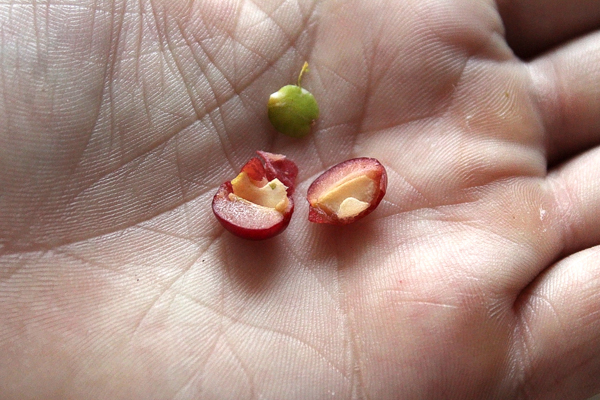
Most sources say to remove the pit and that it will ruin the taste of your food. In the highbush cranberry pie recipe listed below, the writer says she always leaves them in and the pie is amazing. Perhaps it depends on the fruit.
Highbush Cranberry Recipes
There are people who have been harvesting the same highbush cranberries for generations and I’ve come across a number of promising recipes.
- Highbush Cranberry Pie ~ Mennonite Girls Can Cook
- Highbush Cranberry Juice ~ Edible Wild Food
- Highbush Cranberry Ketchup ~ Alaska Floats My Boat
- Highbush Cranberry Jelly ~ The Kitchen Magpie
Highbush Cranberry Medicinal Uses
When you’re talking about using highbush cranberry as medicine, it goes by the common name “crampbark” and is used to relieve muscle cramps. The berries are not the medicinal part, but rather the bark.
That adds another common name into the mix, which only leads to more confusion. Which species of highbush cranberry produces medicinal bark known as crampbark?
I haven’t found a completely definitive answer.
One of my favorite foraging books, Backyard Medicine, cites several old-world sources that use cramp bark and specifically mentions that Chaucer talked about crampbark in his writings. That means that the inedible highbush cranberry (Viburnum opulus) has medicinal bark.
I’ve yet to find any reputable sources that talk about the medicinal properties of either of the US native highbush cranberry species (V. trilobum or V. edule). I’ve seen multiple sources citing “native Americans used the bark and roots” but none of those cite sources, and it’s common enough to attribute herb use to native Americans as a general catch-all for anyone that used a herb in the past. They’re possibly medicinal as well, especially since the differences between species seem to be so minor, but I’m seeking more info.
If you’d like to be sure, you can buy dried crampbark here and know that it’s the medicinal variety. You can also purchase a standardized tincture already made and ready for use.
Beyond general cramp relief, crampbark is used to treat any condition caused by muscle tension. That includes tension headaches and even some rheumatic conditions where tension is a major factor.
Crampbark can relax muscles and allow improved blood flow to a painful area. This increased blood flow helps with high blood pressure, Raynaud’s syndrome and restless legs.
Since crampbark works on both skeletal muscle and smooth muscle, it is also used to relax the uterus. That’s helpful for menstrual cramps and can also help prevent miscarriage.
I’d be hesitant to use any medication during pregnancy, but herbalist Rosemary Gladstar says that crampbark is “possibly one of the best herbs known for preventing miscarriage due to stress and anxiety, and is specifically used for relaxing the uterine muscles.”
According to herbalist Julie Bruton-Seal, a crampbark tincture is used to treat:
- cramps
- menstrual pain
- muscle spasm
- backache
- spastic constipation
- IBS
- high blood pressure
- restless legs
- rheumatic pain
- Raynaud’s syndrome
- poor circulation to the extremities
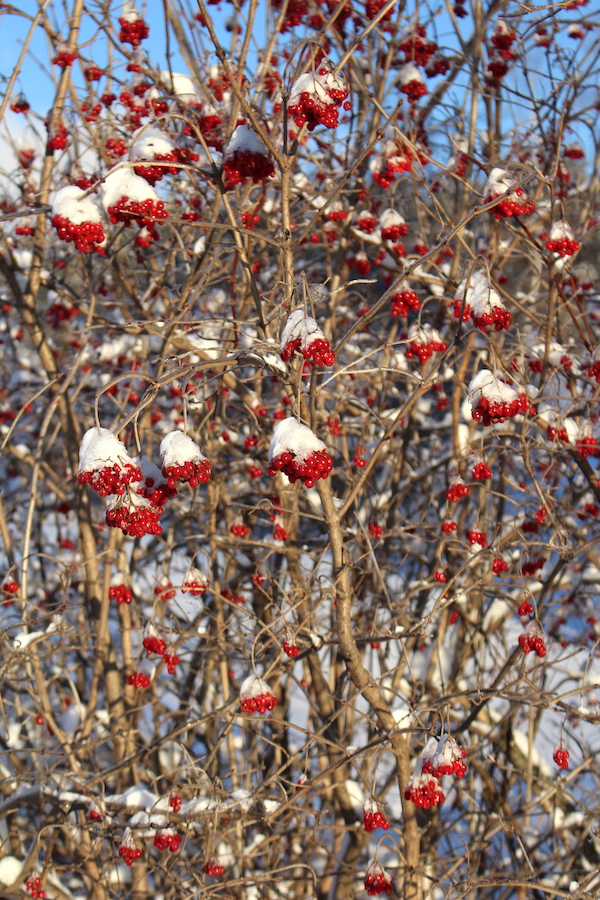
How to Make Crampbark Tincture
Most herbs can be extracted using a simple tincture, where you just pour alcohol over the herb and allow it to sit. Good examples are echinacea tincture and burdock tincture, both of which extract well using a single extraction tincture.
Crampbark needs to be extracted using a double extraction tincture, similar to a reishi mushroom tincture. The process is a bit different than with a mushroom tincture. With mushrooms, the alcohol step happens first followed by the boiling water extraction.
A crampbark tincture is made by first boiling the bark in water. Add the crampbark to a saucepan and then add just enough water to allow all the crampbark pieces to float. Bring the mixture to a boil and then simmer for 10 minutes. This quick water extraction softens the bark and extracts the water-soluble constituents.
Strain out the bark and measure the volume of the water. Add in an equal amount of vodka (80 proof) and then add the crampbark back in. Place the whole mixture in a glass jar and allow it to infuse for about a month. When it’s ready, strain out the bark and bottle the double extraction tincture in amber dropper bottles for later use.
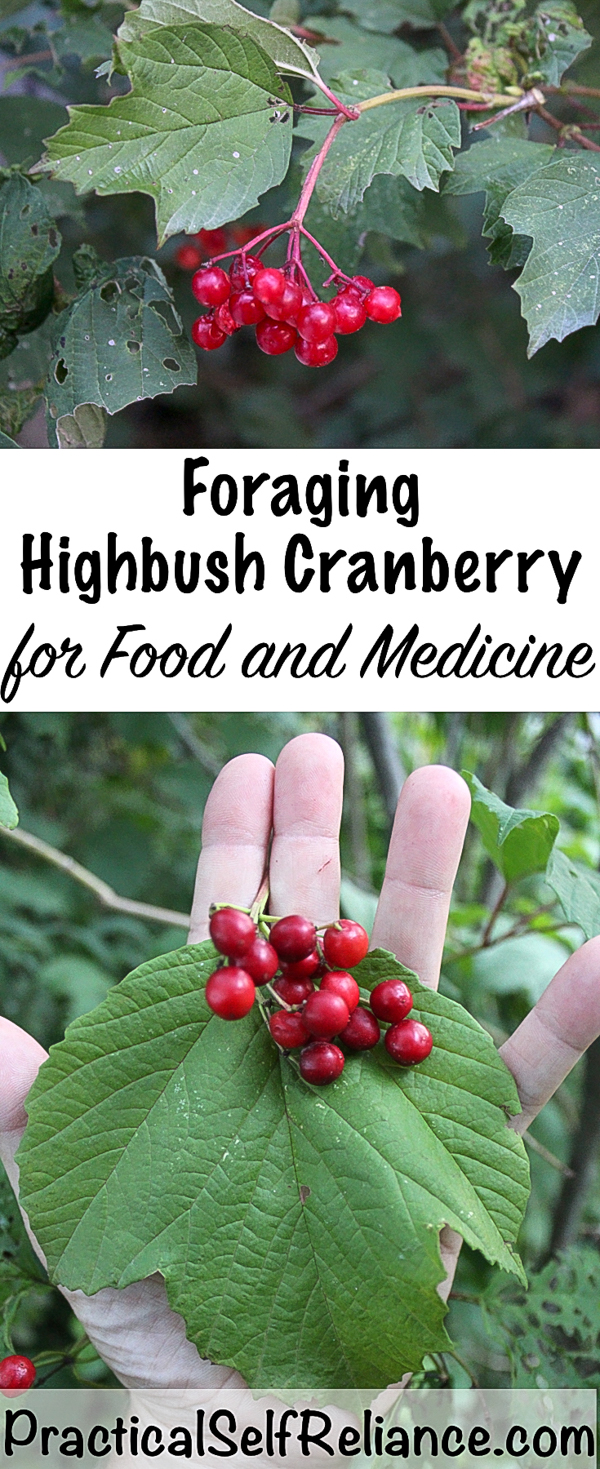


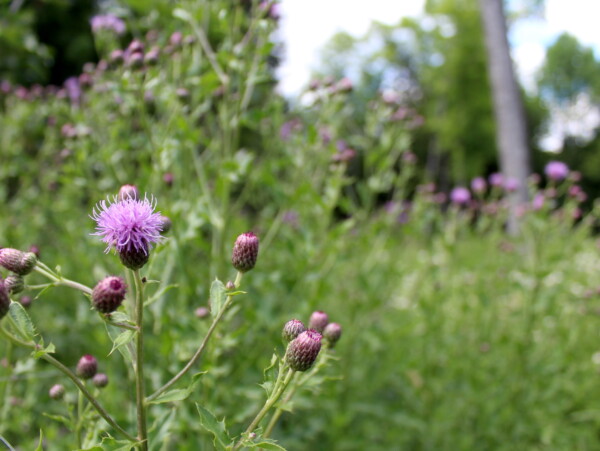
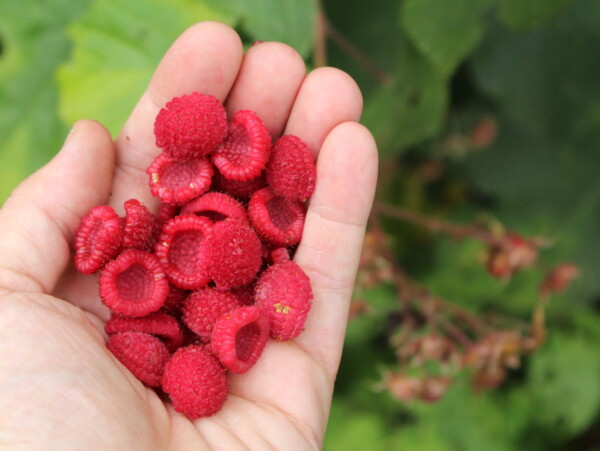
Thank you for this great article!!
grew up in N Minnesota and as a kid we
Would pick the edible berries.
Loved the taste. We would cook them up
and run them thru the hand food processor.
To make a thick sauce.
We Use the sauce with dressing at thanksgiving.
It was great with meat.
I ordered a plant and I did not know until this article
That I got the inedible one. Very bitter and yes spit it right out.
I would love to get the right plant
If anyone knows where to order.
Check out Samuel Thayer at foragersharvest.com I believe they sell highbush cranberry bushes.
Beverly Gray cites Viburnum edule bark as medicinally capable similar to V. opulus.
Rosemary Gladstone’s book indicate that crampbark is V. opulus. I was also trying to determine if V. trilobum could be used with similar results. The pfaf website indicates medicinal qualities of V. trilobum relating to the womb and uterus and references are provided but I haven’t look them up.
love your website!
Julie
Would like a source to buy the eatable high Bush cranberry please..
Hi I’m in canada and these berries are not bitter in harvest late fall at all, and they are truly amazing for bladder infections and anti inflammatory properties I use it all the time , I dont know why it said you get sick from it??? Probabky when they are not ripping ready, Were is this Information coming from? Is it a personal view? The pictures taken are of early blooms, beautiful pictures by the way.
In Ontario, you can purchase 3 different High Bush Cranberries shrub/plant varieties (Viburnum trilobum ‘Alfredo’ and ‘J.N. Select’ plus Viburnum plicatum f. tomentosa ‘Shasta” from the Whiffletree Farm & Nursery in Elora. They ship to all areas in Canada via FedEx but not to the USA as far as I know. They carry all kinds of edible, medicinal, fruit bearing trees, shrubs and plants for colder climes Zones 2-5
Hello!
I am Russian and my mom gifted me a Viburnum opulus. It is common in Russia to pick the berries after a frost as that will take a tiny bit of the bitterness away. The jellies and syrups made from it are considered medicine, so I am a bit sad to see that Western medicine dismisses this berry that has been used for centuries in Ukraine, as toxic. Thanks for your articles, they are very interesting.
Hello, Jenja Bee. What are the medicinal properties of the berries, if you don’t mind sharing? Thank you!
Hi there!
Just wanted to reach out from Switzerland and tell you that I’m just so happy your page exists and I really appreciate your thorough written articles!!! You are amazing!
Please keep going and thank you so much!
<3
Thanks so much! It’s always so lovely to be appreciated =)
Loved harvesting high bush cranberries when living in northern BC. We would raw press the juice and then freeze it in ice cube trays.